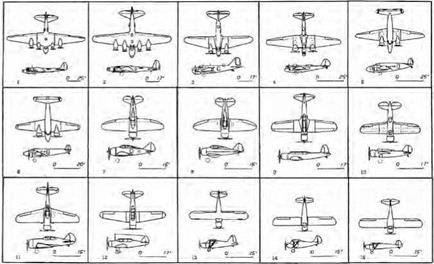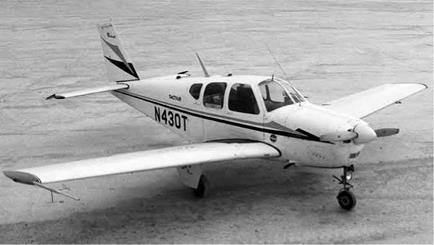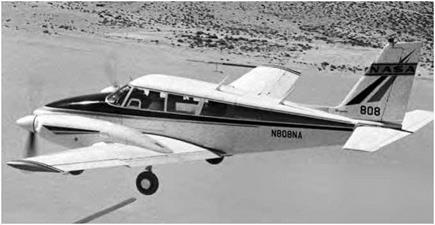Understanding GA Aircraft Behavior and Handling Qualities
As noted earlier, the NACA research on aircraft performance began at the onset of the Agency. The steady progression of aircraft technology was matched by an equivalent progression in the understanding and comprehension of aircraft motions, beginning with extensive studies of the loads, stability, control, and handling qualities fighter biplanes encountered during steady and maneuvering flight.[807] At the end of the interwar period, NACA Langley researchers undertook a major evaluation of the flying qualities of American GA aircraft, though the results of that investigation were not disseminated because of the outbreak of the Second World War and the need for the Agency to focus its attention on military, not civil, needs. Langley test pilots flew five representative aircraft, and the test results, on the whole, were generally satisfactory. Control effectiveness was, on the overall, good, and the aircraft demonstrated a desirable degree of longitudinal (pitch) inherent stability, though two of the designs had degraded longitudinal stability at low speeds. Lateral (roll) stability was likewise satisfactory, but "wide variations” were found in directional stability, though rudder inputs on each were sufficient to trim the aircraft for straight flight. Stall warning (exemplified by progressively more violent airframe buffeting) was good, and each aircraft possessed adequate stall recovery behavior, though departures from controlled flight during stalls in turns proved more violent (the airplane rolling in the direction of the downward wing) than stalls made from wings-level flight. In all cases, aileron power was inadequate to maintain lateral control. Stall recovery was "easily made” in every case simply by pushing forward on the elevator. Overall, if some performance deficiencies existed—for example, the tendency to spiral instability or the lack of lateral control effectiveness at the staff—such limitations were small compared with the dramatic handling qualities deficiencies of many early aircraft just two decades previously, at the end of the First World War. This survey demonstrated that by 1940 America had mastered the design of the practical, useful GA airplane. Indeed, such aircraft, built by the thousands, would play a critical role in initiating many young Americans into wartime service as combat and combat support pilots.[808]
|
The Aeronca Super Chief shown here was evaluated at Langley as part of a prewar survey of General Aviation aircraft handling and flying qualities. NASA. |
During the Second World War, the NACA generated a new series of so-called Wartime Reports, complementing its prewar series of Technical
Reports (TR), Technical Memoranda (TM), and Technical Notes (TN). They subsequently had great influence upon aircraft design and engineering practice, particularly after the war, when applied to high-performance GA aircraft. The NACA studied various ways to improve aircraft performance through drag reduction of single-engine military fighter type aircraft and other designs resulting in improved handling qualities and increased airspeeds. The first Wartime Report was published in October 1940 by NACA engineers C. H. Dearborn and Abe Silverstein. This report described the test results that investigated methods for increasing the high speed for 11 single-engine military aircraft for the Army Air Corps. Their tests found inefficient design features on many of these airplanes indicating the desirability of analyzing and combining all of the results into a single paper for distribution to the designers. It highlighted one of the major problems afflicting aircraft design and performance analysis: understanding the interrelationship of design, performance, and handling qualities.[809]
|
The fifteen different types of aircraft evaluated as part of a landmark study on longitudinal stability represented various configurations and design layouts, both single and multiengine, and from light general aviation designs to experimental heavy bombers. From NACA TR-71 1 (1941). |
The NACA had long recognized "the need for quantitative design cri – terions for describing those qualities of an airplane that make up satisfactory controllability, stability, and handling characteristics,” and the individual who, more than any other, spurred Agency development of them was Robert R. Gilruth, later a towering figure in the development of America’s manned spaceflight program.[810] Gilruth’s work built upon earlier preliminary efforts by two fellow Langley researchers, Hartley A. Soule (later chairman of the NACA Research Airplane Projects Panel that oversaw the postwar X-series transonic and supersonic research airplane programs) and chief Agency test pilot Melvin N. "Mel” Gough, though it went considerably beyond.[811] In 1941, Gilruth and M. D. White assessed the longitudinal stability characteristics of 15 different airplanes (including bombers, fighters, transports, trainers, and GA sport aircraft).[812] Gilruth followed this with another study, in partnership with W. N. Turner, on the lateral control required for satisfactory flying qualities, again based on flight tests of numerous airplanes.[813] Gilruth capped his research with a landmark report establishing the requirements for satisfactory handling qualities in airplanes, issued first as an Advanced Confidential Report in April 1941, then as a Wartime Report, and, finally, in 1943, as one of the Agency’s Technical Reports, TR-755. Based on "real-world” flight-test results, TR-755 defined what measured characteristics were significant in the definition of satisfactory flying qualities, what were reasonable to require from an airplane (and thus to establish as design requirements), and what influence various design features had upon the flying qualities of the aircraft once it entered flight testing.[814] Together, this trio profoundly influenced the field of flying qualities assessment.
But what was equally needed was a means of establishing a standard measure for pilot assessment of aircraft handling qualities.
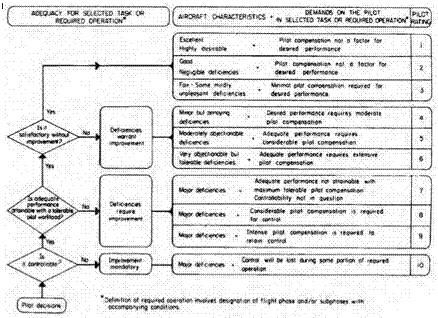 |
|
This proved surprisingly difficult to achieve and took a number of years of effort. Indeed, developing such measures took on such urgency and constituted such a clear requirement that it was one of the compelling reasons underlying the establishment of professional test pilot training schools, beginning with Britain’s Empire Test Pilots’ School established in 1943.[815] The measure was finally derived by two American test pilots, NASA’s George Cooper and the Cornell Aeronautical Laboratory’s Robert Harper, Jr., thereby establishing one of the essential tools of flight testing and flight research, the Cooper-Harper rating scale, issued in 1969 in a seminal report.[816] This evaluation tool quickly replaced earlier scales and measures and won international acceptance, influencing the flight-test evaluation of virtually all flying craft, from light GA aircraft through hypersonic lifting reentry vehicles and rotor – craft. The combination of the work undertaken by Gilruth, Cooper, and
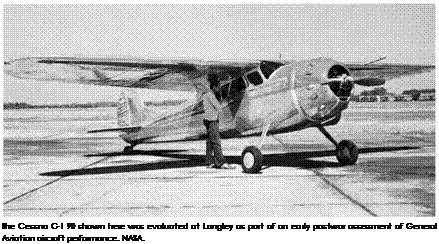 |
|
their associates dramatically improved flight safety and flight efficiency, and must therefore be considered one of the NACA-NASA’s major contributions to aviation.[817]
Despite the demands of wartime research, the NACA and its research staff continued to maintain a keen interest in the GA field, particularly as expectations (subsequently frustrated by postwar economics) anticipated massive sales of GA aircraft as soon as conflict ended. While this was true in 1946—when 35,000 were sold in a single year!—the postwar market swiftly contracted by half, and then fell again, to just 3,000 in 1952, a "boom-bust” cycle the field would, alas, all too frequently repeat over the next half-century.[818] Despite this, hundreds of NACA general-aviation-focused reports, notes, and memoranda were produced— many reflecting flight tests of new and interesting GA designs—but, as well, some already-classic machines such as the Douglas DC-3, which underwent a flying qualities evaluation at Langley in 1950 as an exercise to calculate its stability derivatives, and, as well, update and refine the then-existing Air Force and Navy handling qualities specifications guidebooks. Not surprisingly, the project pilot concluded, "the DC-3
is a very comfortable airplane to fly through all normal flight regimes, despite fairly high control forces about all three axes.”[819]
On October 4, 1957, Sputnik rocketed into orbit, heralding the onset of the "Space Age” and the consequent transformation of the NACA into the National Aeronautics and Space Administration (NASA). But despite the new national focus on space, NASA maintained a broad program of aeronautical research—the lasting legacy of the NACA—even in the shadow of Apollo and the Kennedy-mandated drive to Tranquility Base.
|
The Beech Debonair, one of many General Aviation aircraft types evaluated at the NASA Flight Research Center (now the NASA Dryden Flight Research Center). NASA. |
This included, in particular, the field of GA flying and handling qualities. The first report written in 1960 under NASA presented the status of spin research—a traditional area of concern, particularly as it was a killer of low-flying-time pilots—from recent airplane design as interpreted at the NASA Langley Research Center, Langley, VA.[820] Sporadically, NASA researchers flight-tested new GA designs to assess their handling qualities, performance, and flight safety, their flight test reports frankly detailing both strengths and deficiencies. In December 1964, for example, NASA Flight Research Center test pilot William Dana (one of the Agency’s X-15 pilots) evaluated a Beech Debonair, a conventional-tailed derivative of the V-tail Beech Bonanza. Dana found the sleek Debonair a satisfactory aircraft overall. It had excellent longitudinal, spiral, and speed stability, with good roll damping and "honest” stall behavior in "clean” (landing gear retracted) configuration. But he faulted it for lack of rudder trim that hurt its climb performance, lack of "much warning, either by stick or airframe buffet” of impending stalls, and poor gear – down stall performance manifested by an abrupt left wing drop that hindered recovery. Finally, the plane’s tendency to promote pilot-induced oscillations (PIO) during its landing flare earned it a pilot-rating grade of "C” for landings.[821]
The growing recognition that GA technology had advanced far beyond the state of GA that had existed at the time of the NACA’s first qualitative examination of light aircraft handling qualities triggered one of the most significant of NASA’s GA assessment programs. In 1966, at the height of the Apollo program, pilots and engineers at the Flight Research Center performed an evaluation of the handling qualities of seven GA aircraft, expanding upon this study subsequently to include the handling qualities of other light aircraft and advanced control systems and displays. The aircraft for the 1966 study were a mix of popular single-and twin – engine, high-and low-wing types. Project pilot was Fred W. Haise (subsequently an Apollo 13 astronaut); Marvin R. Barber, Charles K. Jones, and Thomas R. Sisk were project engineers.[822]
As a group, the seven aircraft all exhibited generally satisfactory stability and control characteristics. However, these characteristics, as researchers noted,
Degraded with decreasing airspeed, increasing aft center of gravity, increasing power, and extension of gear and flaps.
The qualitative portion of the program showed the handling qualities were generally satisfactory during visual and instrument flight in smooth air. However, atmosphere turbulence degraded these handling qualities, with the greatest degradation noted during instrument landing system approaches. Such factors as excessive control-system friction, low levels of static stability, high adverse yaw, poor Dutch roll characteristics, and control-surface float combined to make precise instrument tracking tasks, in the present of turbulence difficult even for experienced instrument pilots.
![]() The program revealed three characteristics of specific airplanes that were considered unacceptable if encountered by inexperienced or unsuspecting pilots: (1) A violent elevator force reversal or reduced load factors in the landing configuration, (2) power-on stall characteristics that culminate in rapid roll offs and/or spins, and (3) neutral-to-unstable static longitudinal stability at aft center gravity.
The program revealed three characteristics of specific airplanes that were considered unacceptable if encountered by inexperienced or unsuspecting pilots: (1) A violent elevator force reversal or reduced load factors in the landing configuration, (2) power-on stall characteristics that culminate in rapid roll offs and/or spins, and (3) neutral-to-unstable static longitudinal stability at aft center gravity.
A review indicated that existing criteria had not kept pace with aircraft development in areas of Dutch roll, adverse yaw, effective dihedral, and allowable trim changes with gear, flap and power. This study indicated that criteria should be specified for control-system friction and control-surface float.
This program suggested a method of quantitative evaluating and handling qualities of aircraft by the use of pilot-work-load factor.[823]
As well, all of the aircraft tested had "undesirable and inconsistent placement of both primary flight instruments and navigational displays,” increasing pilot workload, a matter of critical concern during precision instrument landing approaches.[824] Further, they all lacked good
stall warning (defined as progressively strong airframe buffet prior to stall onset). Two had "unacceptable” stall characteristics, one entering an "uncontrollable” left roll/yaw and altitude-consuming spin, and the other having "a rapid left rolloff in the power-on accelerated stall with landing flaps extended.”[825]
The 1966 survey stimulated more frequent evaluations of GA designs by NASA research pilots and engineers, both out of curiosity and sometimes after accounts surfaced of marginal or questionable behavior. NASA test pilots and engineers found that while various GA designs had "generally satisfactory” handling qualities for flight in smooth air and under visual conditions, they had far different qualities in turbulent flight and with degraded visibility. Control system friction, longitudinal and spiral instability, adverse yaw, combined lateral-directional "Dutch roll” characteristics, abrupt trim changes when deploying landing gear flaps, and adding or subtracting power all inhibited effective precision instrument tracking. Thus, instrument landing approaches quickly taxed a pilot, markedly increasing pilot workload. The FRC team explored applying advanced control systems and displays, modifying a light twin-engine
|
The workhorse Piper PA-30 on final approach for a lakebed landing at the Dryden Flight Research Center. NASA. |
Piper PA-30 Twin Comanche business aircraft as a GA testbed with a flight-director display and an attitude-command control system. The result, demonstrated in 72 flight tests and over 120 hours of operation, was "a flying machine that borders on being perfect from a handling qualities standpoint during ILS approaches in turbulent air.” The team presented their findings at a seminal NASA conference on aircraft safety and operating problems held at the Langley Research Center in May 1971.[826]
The little PA-30 proved a workhorse, employed for a variety of research studies including exploring remotely piloted vehicle technology.[827] During the time period of 1969-1972, NASA researchers Chester Wolowicz and Roxanah Yancey undertook wind tunnel and flight tests on it to investigate and assess its longitudinal and lateral static and dynamic stability characteristics.[828] These tests documented representative state-of-the-art analytical procedures and design data for predicting the subsonic longitudinal static and dynamic stability and control characteristics of a light, propeller-driven airplane.[829] But the tests also confirmed, as one survey undertaken by North Carolina State University researchers for NASA concluded, that much work remained to be done to define and properly quantify the desirable handling qualities of GA aircraft.[830]
Fortunately, a key tool was rapidly maturing that made such analysis far more attainable than it would have been just a few years previously: the computer. Given a properly written analytical program, it had the ability to rapidly extract relevant performance parameters from flight-test data. Over several decades, estimating stability and control parameters from flight-test data had progressed through simple analog matching methodologies, time vector analysis, and regression analysis.[831] A joint program between the NASA Langley Research Center and the Aeronautical Laboratory of Princeton University using a Ryan Navion demonstrated that an iterative "maximum-likelihood minimum variance” parameter estimation procedure could be used to extract key aerodynamic parameters based on flight test results, but also showed that caution was warranted. Unanticipated relations between the various parameters had made it difficult to sort out individual values and indicated that prior to such studies, researchers should have a reliable mathematical model of the aircraft.[832] At the Flight Research Center, Richard E. Maine and Kenneth W. Iliff extended such work by applying IBM’s FORTRAN programming language to ease determination of aircraft stability and control derivatives from flight data. Their resulting program, a maximum likelihood estimation method supported by two associated programs for routine data handling, was validated by successful analysis of 1,500 maneuvers executed by 20 different aircraft and was made available for use by the aviation community via a NASA Technical Note issued in April 1975.[833] Afterwards, NASA, the Beech Aircraft Corporation, and the Flight Research Laboratory at the University of Kansas collaborated on a joint flight test of a loaned Beech 99 twin-engine commuter aircraft, extracting longitudinal and lateral-directional stability derivatives during a variety of maneuvers at assorted angles of attack and in clean and flaps-down condition. "In general,” researchers concluded, "derivative estimates from flight data for the Beech 99 airplane were quite consistent with the manufacturer’s predictions.”[834] Another analytical tool was thus available for undertaking flying and handling qualities analysis.












